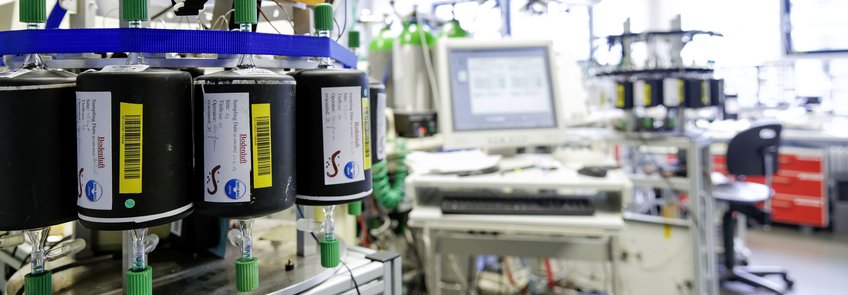
Stable Isotope Analytics (BGC-IsoLab)
Highly precise isotope analysis of atmospheric gases
The Stable Isotope Service Group (BGC-IsoLab) measures stable isotope ratios in atmospheric gas samples, but also in soil samples, plants or water. In collaboration with external partners, we conduct research on topics such as new instrumentation, calibration and isotope standardization. BGC-IsoLab additionally serves as a central calibration laboratory (CCL) of the World Meteorological Organisation (WMO) for CO2 isotope measurements in air and provides reference material (JRAS) for other laboratories. A similar role is envisaged in the future for the analysis of methane isotopes.
Carbon isotopes
Isotopes are atoms of the same element with the same number of electrons and protons but different numbers of neutrons. For example, carbon has two stable isotopes, 12C and 13C, with natural abundances of 98.9 % and 1.1 %, respectively. A third isotope 14C is radioactive (half-life: ~ 5730 years), has an abundance of ~10-12 , and is used for radiocarbon dating. The extra neutron in the heavy isotope leads to a very small weight difference between the lighter (12C) and heavier (13C) isotope. The incorporation of different isotopes into molecules, e.g. 12CO2 and 13CO2, causes molecules to have slightly different weights, which in turn affects their reactivity in biogeochemical and physical processes.
Photosynthesis is selective
Using sunlight, photosynthesising organisms convert CO2 and water into organic matter. During this process, the catalysing enzymes preferentially use the isotopically light 12CO2, rather than the heavier 13CO2. Therefore the produced organic matter has less 13C than the air CO2, which is enriched in the heavier isotope. While the resulting variations are extremely small, they are highly significant and robust over time. All fossil fuels have been generated by photosynthesis in the distant past. Therefore, the combustion of oil, coal and natural gas leads to an addition of isotopically light (12C containing) CO2 to the atmosphere. We can analyse this long-term addition of isotopically light CO2 to the atmosphere and relate it to anthropogenic activity. We also observe annual variability which is correlated to the growth of plants during spring/summer (uptake of 12CO2) and the biodegradation of organic matter during autumn/winter (release of 12CO2).
Climate of the past
Isotopic signatures of organic molecules found in Earth’s geological archives (sediments, soils, oil, ice cores) can also be used to reconstruct past climate change. The water that plants use for photosynthesis is ultimately derived from atmospheric moisture and the resultant rain. The hydrogen isotopic composition of the water depends on a number of factors including, but not limited to temperature, altitude, and amount of rain. Changes in the hydrological cycle affect the isotopic signature of the water that plants use to produce organic matter, and the plant organic matter subsequently records these changes.
The hydrogen isotopic signature of higher plant-derived organic matter (e.g. n-alkanes), that is found in marine/lacustrine sediments, can therefore be used to study palaeohydrological changes.
Isotopes in the hydrological cycle
The BGC IsoLab is specialised in analysing the13C/18O and the13C/2H isotopic signatures of CO2 and CH4 in atmospheric samples. It has developed a standard based on carboantes for the analyses of isotopes of CO2 in air. This “Jena Reference Air Set” is used by international laboratories to standardise their CO2 measurements. The BGC-IsoLab acts as central calibration laboratory for the Global Atmospheric Watch community since 2010 and has been measuring isotopic ratios of CO2 and CH4 since 2002 and 2012, respectively, from samples coming from all over the world. Such long term records of gases relevant to climate change enable scientists to better study anthropogenic and natural climate change with its impact on humans and the natural environment.
Atmospheric O2 concentration change
In addition to these direct stable isotope observations, we use the same technology to measure present day O2 concentrations with very high precision. The well known, human driven increase in CO2 is accompanied by a (less well publicised) decline of O2 in the atmosphere in a complementary fashion. For every fossil fuel carbon combusted to CO2, one molecule of O2 is removed from the atmosphere. Hence, there is a stoichiometric relationship. However, the change of the atmospheric O2 concentration happens against a much larger background (O2 has a concentration of ~21 % in air, CO2 only ~0.04%). Therefore, making these measurements at the required levels of precision and accuracy is a challenge, which we have mastered successfully by developing our own equipment and designing our own sample handling and calibration protocols. By studying the record of both, CO2 and O2, we get a deeper insight into the carbon cycle which we would not be able to get by studying CO2 alone.